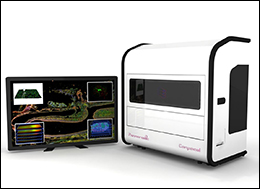12 July 2017
 With more than 1.1million people globally diagnosed with prostate cancer each year, and more than 300,000 patient deaths, the University of South Australia is developing technology to accurately detect prostate cancer to reduce unnecessary surgery and improve treatment outcomes.
With more than 1.1million people globally diagnosed with prostate cancer each year, and more than 300,000 patient deaths, the University of South Australia is developing technology to accurately detect prostate cancer to reduce unnecessary surgery and improve treatment outcomes.
With a significant contribution of $250,000 from The Hospital Research Foundation (THRF), UniSA has secured a 3D Histech Pannoramic confocal scanner to assist them in their groundbreaking work in prostate cancer imaging.
The University has a specific translational research program aiming to develop new detection and visualization technologies to predict which patients need immediate radical intervention.
Professor Doug Brooks from the University’s School of Pharmacy and Medical Sciences says the new piece of equipment is a game changer for their research program visualizing prostate cancer.
“We are developing several technologies to accurately visualize the disease process in prostate cancer patient samples to confirm diagnosis, help determine the size of the cancer, define tumor architecture and determine if the cancer is aggressive,” Prof Books says.
“We are also developing new imaging agents that ultimately will mean we can visualize cancer in a live biopsy from a patient.
“Although these new imaging technologies have specific applications for prostate cancer, the technology will apply to other cancers, giving this project wider potential in cancer imaging.
With proof of principle already established, state of the art imaging equipment was required to translate the new technologies ready for translation clinical practice.
“A specific infrastructure requirement was identified that would boost our imaging capacity, so thanks to the generosity of THRF, the equipment can now be used to facilitate the technology development in a pre-clinical study, ready for use in clinical setting,” Prof Books says.
UniSA’s Pro Vice Chancellor Health Sciences, Prof Robert Vink, praised the support of those enabling the research to move forward.
“We offer great thanks to THRF who have partnered with us to fund this machine,” Prof Vink says.
“With their generous support, we are able to take research and technology developed here in South Australia and apply that to make a real difference to patients.”
THRF’s Chief Executive Officer, Paul Flynn says their commitment to the new piece of vital equipment has only been possible thanks to the support of THRF’s generous donors and ticket buyers in the Hospital Research Home Lottery.
“We are extremely proud to enable the purchase of the new confocal scanner to contribute to world-class research that is set to deliver tremendous impact in our community,” Flynn says.
“This piece of equipment is essential in changing the way clinicians diagnose and predict the aggressiveness of prostate cancer. It will help to save lives.”
Media contact: Georgia Aish mobile: +61 435 658 176 email: Georgia.Aish@unisa.edu.au



